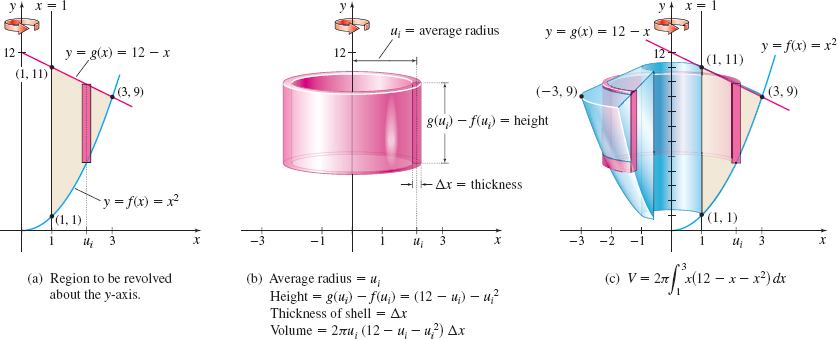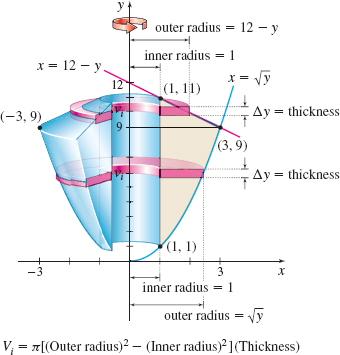EXAMPLE 2Finding the Volume of a Solid: Revolving About the y-Axis
Find the volume V of the solid generated by revolving the region bounded by the graphs of f(x)=x2 and g(x)=12−x to the right of x=1 about the y-axis.
Solution Using the shell method: Figure 33(a) shows the graph of the region to be revolved and a typical rectangle.

As shown in Figure 33(b), in the shell method, we partition the x-axis and use vertical shells. A typical shell has height hi=g(ui)−f(ui)=(12−ui)−u2i=12−ui−u2i, and volume Vi=2πui(12−ui−u2i)Δx. Figure 33(c) shows the solid of revolution. Notice that the integration takes place from x=1 to x=3. The volume V of the solid of revolution is V=2π∫31x(12−x−x2) dx=2π∫31(12x−x2−x3) dx=2π[6x2−x33−x44]31=2π[(54−9−814)−(6−13−14)]=116 π3 cubic units
428
Using the washer method: Figure 34 shows the solid of revolution and typical washers.

In the washer method, we partition the interval [1,11] on the y-axis and use horizontal washers. At y=9, the function on the right changes. The volume of a typical washer in the interval [1,9] is Vi=π[√vi2−12]Δy=π(vi−1)Δy
The volume of a typical washer in the interval [9,11] is Vi=π[(12−vi)2−12]Δy=π(143−24vi+v2i)Δy
The volume V of the solid of revolution is V=π∫91(y−1) dy+π∫119(143−24y+y2) dy=π[y22−y]91+π[143y−12y2+y33]119 =π[(812−9)−(12−1)]+π(143(2)−(12)(121−81)+1133−933)=32π+203π=116π3 cubic units